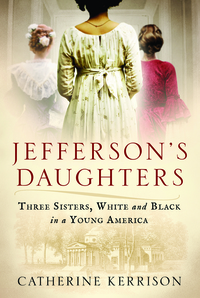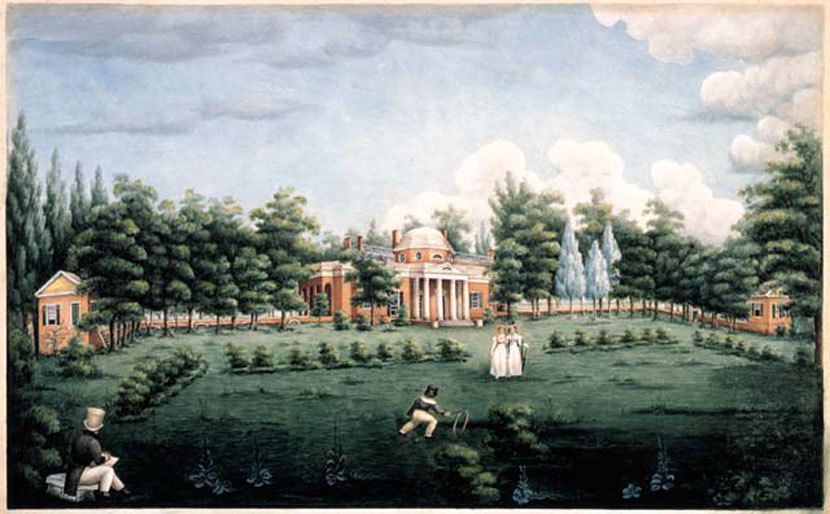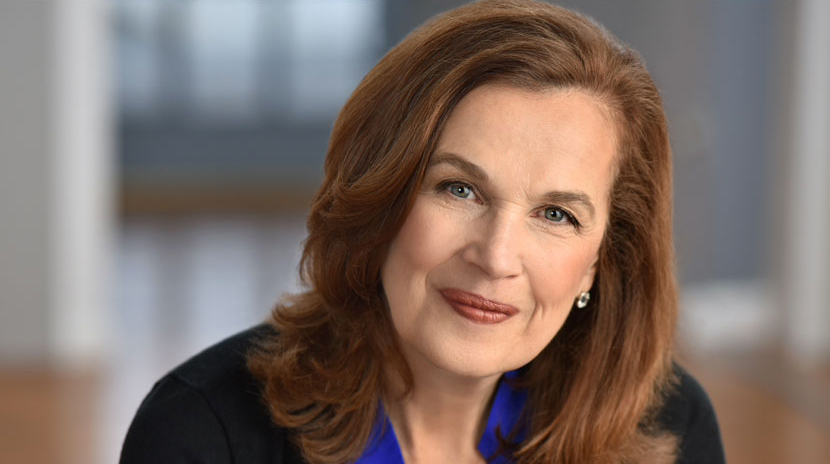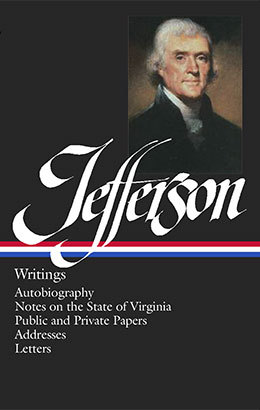Thomas Jefferson had three daughters: Martha and Maria by his wife, Martha Wayles Jefferson, and Harriet by his slave, Sally Hemings, his wife’s half-sister. In her new book Jefferson’s Daughters: Three Sisters, White and Black, in a Young America (Ballantine, 2018), historian Catherine Kerrison recounts the divergent life stories of these three women—and how their lives reflect both the possibilities open to women in Revolutionary America and the constraints imposed on them.

The three women shared a father but not much else. Martha and Maria were educated in an elite convent school in Paris during Jefferson’s diplomatic tenure there; when they returned home, however, the sisters found their options limited by the laws and customs of Virginia. Harriet Hemings took a different route, managing to escape slavery—apparently with Jefferson’s help—and left Monticello in favor of an uncertain future in which she would attempt to pass as white.
In a starred review, Publishers Weekly called Kerrison’s new book, which goes on sale next week, “Incisive and elegant . . . at once a fabulous family story and a stellar work of historical scholarship.” Gearing up for the new semester at Villanova University, where she teaches early American and women’s history, Kerrison took time out of her schedule to answer a few questions for us.

Library of America: For all the shelves of books written about Thomas Jefferson and Monticello, your approach in Jefferson’s Daughters feels quite new. How did the idea for this project come about?
Catherine Kerrison: When I was researching my first book on women in the eighteenth-century south, I had to pore through countless collections of men’s papers looking for the precious nuggets I might be able use to recover women’s reading, thinking, and writing. It was a long and frequently tedious slog. So when I saw the voluminous collection of letters of Martha Jefferson Randolph and her family at the University of Virginia, I was elated at the prospect of diving into a ready-made archive!
But more important than the appeal of abundant sources was the context of our own times. As the United States elected its first black president and twice watched a woman run for the presidency, many Americans began to talk about living in a post-racist and post-feminist society. But vitriol continued to be heaped on people of color and women (particularly ambitious women). Commentators offered smart analyses on the dynamics of racism and sexism in American society, but it seemed to me that they remained somewhat puzzled at the tenacity of these structures. As a historian of early America, I know that scholars have done important work on race and gender to explain how deeply rooted these structures are in the American experience. But I wasn’t sure that much of it was being read outside the academy. The stories of Jefferson’s daughters allowed me to present the insights of that work in a way that I hope readers will find interesting, informative, and thought provoking.
LOA: What do we learn about Jefferson by looking at him not just as a founding father, but as a father to his children, both free and enslaved?
Kerrison: I think that by looking at Jefferson as father, we see him at his most unself-edited and honest. Jefferson was always conscious of the way he presented himself to both his contemporaries and posterity as an advocate of liberty and equality. But in examining his parenting, how he prepared his daughters for the lives he wished them to lead, it becomes abundantly clear that while he rejected monarchy and notions of aristocratic nobility, he continued to believe that hierarchies of gender and race existed in nature. He educated Martha and Maria to become agreeable wives and sensible mothers of elite men; Harriet’s education—her work as a weaver—was of a piece with the work Jefferson expected enslaved and Native American women to do. Although he ensured his enslaved sons’ ability to support themselves by entrusting their training to John Hemings, a talented enslaved carpenter, he never treated them as he did his white children and grandchildren. Indeed, I think this refusal to acknowledge the place of his shadow family and their mother in his life is itself compelling evidence of the limits of Jefferson’s thinking—in spite of his soaring words.
LOA: What challenges did you face in trying to balance the stories of the three daughters, one of whom lived a long and relatively well-documented life, another a shorter life with fewer written traces, and a third who, in terms of a paper trail, is almost a ghost?
Kerrison: Indeed, that was a challenge I recognized from the very beginning! Martha and her eleven surviving children generated a treasure trove of records, so I knew I had to be careful to keep her from overtaking the entire story. Maria died at twenty-five, too young to leave a written record for her only surviving child. And the limited information we have about Harriet all comes from other people. But I was determined to give each “equal time” because I felt strongly that each woman was significant in her own right and had a story worth telling, regardless of the availability of the sources. The challenge for Martha’s story was to compress it to a third of the book, rather than telling every detail of her life. Because she identified so closely with the intellectual life of her father—and taught her daughters to do the same—I chose that as her narrative thread.
My dilemma for the other two sisters was precisely the opposite: how do I convey the significance of their lives in equal measure with so few sources? The answer was to look very closely at the evidence I did have and to ask a lot of questions of it. In Maria’s case, I carefully parsed out the letters from her childhood and her marriage to reveal a very different person from the one that usually appears in Jefferson biographies. I compared her Philadelphia education to Martha’s Parisian one to understand why she did not revel in the intellectual life as her elder sister did. In a word, I tried to take her on her own terms.
In telling Harriet’s story I relied on much the same strategies. Thanks to the work of historians such as Lucia Stanton and Annette Gordon-Reed, we know a great deal more about slavery at Monticello than we knew even twenty years ago. Building on the foundation of their work, I asked questions about Harriet’s childhood: how would the promise of freedom in adulthood have shaped her experience of enslavement and her family relationships? I attended closely to her brother’s account of her departure to try to discern her life’s goals beyond Monticello. And, in time, I realized that the story of the search for Harriet Hemings—both the content of what I found as well as the process—was itself a critical component to understanding her life and the choices she made.

LOA: Publishers Weekly rightly calls Jefferson’s Daughters “a stellar work of historical scholarship.” Perhaps the most impressive section is your chapter “Passing,” which reads like a detective story as you describe the process of trying to follow Harriet Hemings’s trail after she leaves Monticello and disappears into white society. What do you hope readers will learn about the practice and craft of history, especially women’s history, from reading your book?
Kerrison: Several things! The first is to understand that the absence of sources is not at all a reliable indicator of the worthiness of the topic. In the past, to the extent that (mostly) male historians even thought to ask, they pointed to the lack of sources to show that women didn’t do anything, or at least anything worth recording. In fact, the earliest pioneers of women’s history were often discouraged by their dissertation advisors, and told that this history couldn’t be done.
The second point is to watch how historians of marginalized people find creative ways to get around the challenges the sources present. For example, scholars find that they learn a great deal just by posing questions that haven’t been asked before and raising several possible scenarios to investigate. That usually means building context to help arrive at a satisfying answer. So, for example, I asked: what kind of community of women and girls lay behind the imposing façade of the French convent school that became the home of twelve-year-old Martha Jefferson? Or, who was in Philadelphia when Maria was there, who might have shaped her thinking about women’s place in the new nation? Or, how would Harriet Hemings have gone about preparing to pass as a freeborn white woman in her dress and conduct?
Last, even when we cannot find the precise answers to our questions, we can still learn a great deal by asking them: in Martha’s case, we discover the ways in which aristocratic French nuns exerted authority that American women could only dream about; and in Maria’s, we see the limits of Revolutionary-era thinking about women’s status even among the leading women of the republic. And, as we ask about Harriet’s preparations to leave her family behind, we are forced to consider the cruelty of conditions of life in the United States for enslaved people that made breaking ties with your birth family look like a better option. In considering these questions, readers see how these individual stories have much larger implications, and hopefully how they can help us understand our own society more clearly.
LOA: Until it was updated in 2011, the Chronology in the Library of America volume Thomas Jefferson: Writings (1984), written by Merrill Peterson, the preeminent Jefferson scholar of his generation, included this entry for 1802:
In July, James T. Callender, disappointed office-seeker, commences libels of Jefferson, including allegation that he fathered children by his slave Sally Hemings.
In 2018, this statement seems remarkable both for its easy dismissal of the Jefferson–Hemings relationship and for characterizing Callender’s allegation as libelous. How has the use of DNA evidence, and the new scholarly consensus about the relationship that has crystallized around it, changed the way we understand the Founders and the early history of the country?
Kerrison: It’s important to begin by understanding some of the reasons why it took so long to come to that scholarly consensus: the struggle of women and people of color to have their questions, concerns, and scholarship taken seriously by institutions dominated by white men; the overt racism that excluded the testimony of descendants of the Monticello slave community for over a century; and the impulse to “defend” the Founder most closely identified with America’s ideals of liberty and equality from accusations that, in fact, he acted no differently than his slaveholding peers.
However, as the academy itself diversified, historians began to take seriously questions and topics that had been previously dismissed, including Jefferson’s relationship with Sally Hemings. Still, the resistance to coming to terms with this aspect of the eminent Founder’s life remained so substantial, it would require “proof” of the type historians rarely find in the archive but that science can sometimes provide. The DNA test in 1998 irrefutably linked Eston Hemings (Sally’s youngest child) to the Jefferson male line, even if not directly to Thomas. Taken together with the more recent scholarship, the DNA results make it increasingly untenable to deny Jefferson’s long-standing relationship with Sally Hemings.
This opens up new ways of understanding not just Jefferson, but our whole founding period. Yes, this evidence forces us to confront tangled histories that previously had been compartmentalized or, worse, ignored. But it also enables us to acknowledge the deep connections that bind us. As the enormous popularity of DNA testing shows, Americans are curious to know more about those connections. And while the results may be painful for some people who identify as white, many Americans are discovering their mixed race ancestry. This is infinitely less surprising for people of color who have long known that, contrary to the Founders’ insistence on the differences between blacks and whites, this connectedness is the true American story.
Catherine Kerrison is an associate professor of history at Villanova University, where she teaches courses in Colonial and Revolutionary America and women’s and gender history. She holds a PhD in American history from the College of William and Mary. Her first book, Claiming the Pen: Women and Intellectual Life in the Early American South, won the Outstanding Book Award from the History of Education Society.




